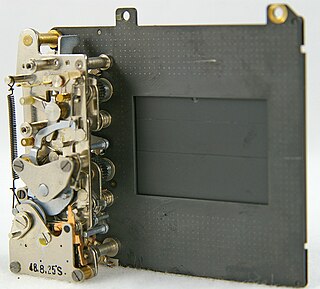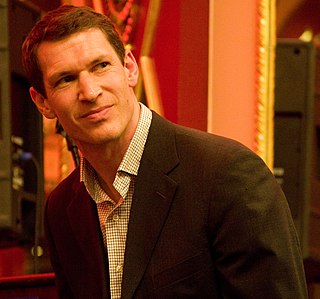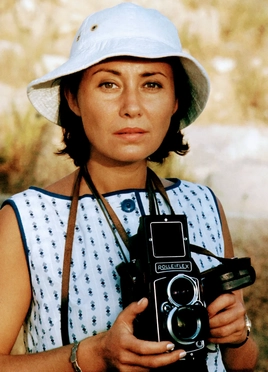Related Research Articles

In camera design, a focal-plane shutter (FPS) is a type of photographic shutter that is positioned immediately in front of the focal plane of the camera, that is, right in front of the photographic film or image sensor.

Stock photography is the supply of photographs which are often licensed for specific uses. The stock photo industry, which began to gain hold in the 1920s, has established models including traditional macrostock photography, midstock photography, and microstock photography. Conventional stock agencies charge from several hundred to several thousand US dollars per image, while microstock photography may sell for around US$25 cents. Professional stock photographers traditionally place their images with one or more stock agencies on a contractual basis, while stock agencies may accept the high-quality photos of amateur photographers through online submission.
Corporate manslaughter is a criminal offence in English law, being an act of homicide committed by a company or organisation. In general, in English criminal law, a juristic person is in the same position as a natural person, and may be convicted for committing many offences. The Court of Appeal confirmed in one of the cases following the Herald of Free Enterprise disaster that a company can, in principle, commit manslaughter, although all defendants in that case were acquitted.

The Canon A-1 is an advanced-level single-lens reflex (SLR) 35 mm film camera for use with interchangeable lenses. It was manufactured by Canon Camera K. K. in Japan from April 1978 to 1985. It employs a horizontal cloth-curtain focal-plane shutter with a speed range of 30 to 1/1000 second plus bulb and flash synchronization speed of 1/60 second. It has dimensions of 92 millimetres (3.6 in) height, 141 millimetres (5.6 in) width, 48 millimetres (1.9 in) depth and 620 grams (22 oz) weight. Unlike most SLRs of the time, it was available in only one color; all black. The introductory US list price for the body plus Canon FD 50 mm f/1.4 SSC lens was $625; the camera body was generally sold with a 30–40% discount.

The Canon AE-1 is a 35 mm single-lens reflex (SLR) film camera for use with interchangeable lenses. It was manufactured by Canon Camera K. K. in Japan from April 1976 to 1984. It uses an electronically controlled, electromagnet horizontal cloth focal plane shutter, with a speed range of 2 to 1/1000 second plus Bulb and flash X-sync of 1/60 second. The camera body is 87 mm tall, 141 mm wide, and 48 mm deep; it weighs 590 g. Most are black with chrome trim, but some are all black.
Thomas Junta was an American hockey dad from Reading, Massachusetts who was convicted of involuntary manslaughter in 2002 after his attack on Michael Costin led to Costin's death. Costin was the informal referee of a pick-up hockey game involving the men's sons. The attack and the fight which ensued was witnessed by about a dozen children, including Junta's son and Costin's three sons.

The Canonflex is a Canon 35 mm film single-lens reflex (SLR) camera introduced in May 1959. Its standard lens is the Canon Camera Co. Super-Canomatic R 50mm lens f/1.8. The camera was in production for one year before it was replaced by the Canonflex R2000, adding a 1/2000 sec. shutter speed.

The history of the single-lens reflex camera (SLR) begins with the use of a reflex mirror in a camera obscura described in 1676, but it took a long time for the design to succeed for photographic cameras. The first patent was granted in 1861, and the first cameras were produced in 1884, but while elegantly simple in concept, they were very complex in practice. One by one these complexities were overcome as optical and mechanical technology advanced, and in the 1960s the SLR camera became the preferred design for many high-end camera formats.

The Canon EOS RT is a 35mm single-lens reflex camera produced by Canon and sold from 1989 to 1992. The camera is essentially an EOS 630/EOS 600 with a pellicle mirror. Only 25,000 were manufactured at the end of the EOS 630 production run, so the EOS RT was technically "out of production" before it ever went on sale.

Spirit photography is a type of photography whose primary goal is to capture images of ghosts and other spiritual entities, especially in ghost hunting. It dates back to the late 19th century. The end of the American Civil War and the mid-19th Century Spiritualism movement contributed greatly to the popularity of spirit photography. Photographers such as William Mumler and William Hope ran thriving businesses taking photos of people with their supposed dead relatives. Both were shown to be frauds, but "true believers", such as Sir Arthur Conan Doyle, refused to accept the evidence as proof of a hoax.
Rick Castro is an American photographer, motion picture director, stylist, curator and blogger whose work focuses on bondage and sado-masochistic sex.

The Canon EOS 100 is a 35 mm autofocus SLR camera introduced by Canon in 1991. It was marketed as the EOS Elan in North America. It was the second camera in the EOS range to be targeted at advanced amateur photographers, replacing the EOS 650.

Timothy Alistair Telemachus Hetherington was a British photojournalist. He produced books, films and other work that "ranged from multi-screen installations, to fly-poster exhibitions, to handheld device downloads" and was a regular contributor to Vanity Fair.

Wildlife Photographer of the Year is an annual international wildlife photography competition staged by the Natural History Museum in London, England. There is an exhibition of the winning and commended images each year at the museum, which later tours around the world. The event has been described as one of the most prestigious photography competitions in the world.

The Leica copies originate from the Leica camera that was launched by Ernst Leitz, Wetzlar in 1925, using the Leica 39mm screw mount of 26 threads per inch, and the standard 35mm film. The design was carried out by Oskar Barnack, beginning in 1913 by building a camera for 24×36 mm negatives that by now is called the Ur-Leica; but Ernst Leitz did not decide to manufacture it until 1924. Once started, the Leica production volume doubled each year; in 1929, some 16.000 cameras were produced. In 1930, an improved model with interchangeable lens was introduced, followed a year later by the fully developed Leica II with standardized film to lens flange distance, and in 1932 the basic Leica Standard; the Leica concept was established. This camera's features are the basis for defining a Leica copy.
Leica R4, R5, R6, R7 were 35 mm SLR cameras manufactured by Leica between 1980 and 1997 and belonged to the manual focusing R-System, which was offered from 1965 to 2009.

Steven Charles Kanumba was a Tanzanian actor and director of Sukuma heritage, born in Shinyanga Region. Kanumba died in 2012 at the age of 28, for which actress Elizabeth Michael was convicted of involuntary manslaughter and sentenced two years in prison in November 2017. Over 30,000 people were estimated to have attended his funeral. He was described as "Tanzania's most popular film star", and appeared in Nollywood films.

The Nikon was the first camera introduced by the optical manufacturer Nippon Kogaku KK. It is a 35mm rangefinder camera, in retrospect known as the Nikon I. The original design was approved by September 1946, and the camera was released in March 1948. At first, it was sold locally, and it did not come to the attention of the western media until 1950, when photographers from the magazine Life were shown photographs taken with these cameras. The lenses draw special attention, like the Nikkor-P.C 1:2 f=8.5cm. A demand to fit Nikkors to the reporters' Leicas were immediately met at the factory in Tokyo, and soon the word spread about these Japanese lenses which were just as good as, or possibly better than their German counterparts. The camera design was strongly inspired by the German Contax and Leica cameras. After careful studies of these, Nippon Kogaku had decided to base their camera on the Contax, but substitute the complicated shutter design for the cloth focal plane shutter of the Leica, these being considered the best features from either camera.

Marilyn Jean Stafford was a British photographer. Born and raised in the United States, she moved to Paris as a young woman, where she began working as a photojournalist. She settled in London, but travelled and worked across the world, including in Tunisia, India, and Lebanon. Her work was published in The Observer and other newspapers. Stafford also worked as a fashion photographer in Paris, where she photographed models in the streets in everyday situations, rather than in the more usual opulent surroundings.

The Mamiya RB67 is a professional medium format single-lens reflex system camera manufactured by Mamiya. There are three successive models: the RB67 Professional, RB67 Pro-S and RB67 Pro-SD. It is primarily designed for studio use, but can also be used in the field.
References
- ↑ Date information sourced from Library of Congress Authorities data, via corresponding WorldCat Identities linked authority file (LAF) .
- ↑ Joe Eaton (8 November 2008). "The final shoot". The Roanoke Times .
- ↑ Chris Cheesman (13 September 2007). "Photographer Bob Shell convicted over model's death Archived October 12, 2007, at the Wayback Machine ". Amateur Photographer .
- ↑ Motion to dismiss. vawd.uscourts.gov. (PDF).
- ↑ Shawna Morrison (August 30, 2007). "Shell tells his version of model's deadly day". The Roanoke Times .